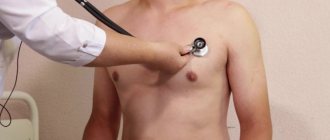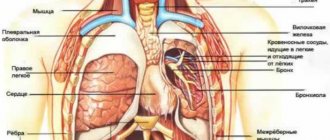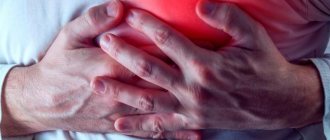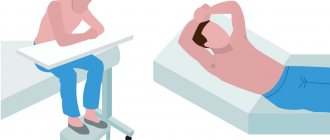general information
There are 12 pairs of intercostal nerves in the human body. They originate from the roots of the thoracic spinal cord and cover the entire chest, adjacent to the peritoneum, muscles, skin and mammary glands. The individual fibers of each nerve are responsible for tissue sensitivity, motor function and regulation of the functioning of all structures. Accordingly, damage or inflammation in any area can radiate pain to a variety of parts of the body.
The sensations can imitate diseases of internal organs: myocardial infarction, angina pectoris, pancreatitis, gastritis, cholecystitis, etc. In some cases, only a doctor can accurately determine the nature of the pain after a full examination. That is why it is important to seek help promptly if chest pain occurs.
Make an appointment
Case from practice
A woman came to the appointment with complaints that her heart was aching and pain was radiating to her back. She had a history of small focal infarction. Currently, the unpleasant sensations continue for two weeks, they subside and resume. Deterioration occurs after physical activity and changes in body position. Nitroglycerin and Validol do not help. No abnormalities were found on the ECG; the study was carried out at the height of the attack. X-ray and CT scan of the thoracic region revealed the initial stages of a hernia in 3-4 vertebrae. Prescribed: Movalis, Dolobene-gel, electrophoresis with Novocaine. A week later, the condition returned to normal; a complex of exercise therapy and massage were recommended.
Forms
There is no special classification of the disease. There are several separate forms depending on the mechanism of occurrence:
- radicular: associated with irritation of the spinal cord roots at the point of their exit from the spinal column;
- reflex: associated with overstrain of muscle fibers at the site of the nerve passage.
There is also a classification of neuralgia depending on:
- causes: primary (associated with damage or inflammation of the nerve itself) and secondary (due to other diseases);
- localization: unilateral and bilateral;
- course of the disease: acute and chronic.
Causes
The list of main causes of intercostal neuralgia includes:
- degenerative-dystrophic diseases of the spine: osteochondrosis, arthrosis, hernias and protrusions of discs, etc.;
- uneven or excessive load on the spine and back muscles (due to carrying heavy objects, poor posture, etc.);
- spinal column deformities (primarily scoliosis);
- diseases of the nervous system, in particular multiple sclerosis;
- infectious lesions: tuberculosis, herpes zoster, influenza;
- injuries of the spine and chest, surgical interventions in this area;
- tumors in the ribs, sternum, spinal column;
- taking certain medications;
- increased load on the respiratory muscles and abdominal muscles;
- increased intra-abdominal pressure, including during pregnancy.
In addition, intercostal neuralgia can occur secondary to other diseases, for example, pleurisy, pathology of the digestive system, kidney disease, thyrotoxicosis, and immunodeficiency states. Adolescents during the period of active skeletal growth may also experience similar symptoms.
Which categories of people are more likely to experience cardioneurosis?
The key reason for the development of heart neurosis is the effect of a stressful situation on the body. The first question that a psychiatrist asks a patient with suspected cardiac neurosis concerns the presence of problems in life and recent psychological trauma experienced. Perhaps a person’s loved one has died or fallen ill, problems have arisen in school or at work, or financial difficulties have arisen.
Heart neurosis often occurs in people in adolescence against the background of hormonal changes and a negative stressful environment. In most cases, the disorder occurs in women and girls.
The problem with neurosis is that a person, when it manifests itself for a long time, considers himself truly sick. He spends a lot of time, effort and financial resources traveling to doctors and trying to establish the correct diagnosis. But the solution to the problem lies exclusively in psychological treatment using properly selected drugs and techniques.
Symptoms
The main symptom of intercostal neuralgia is severe pain in the chest along the nerve. As a rule, it occurs suddenly and resembles an electric shock, gradually spreading along the ribs. The nature of the sensations can be different: shooting, pulsating, constant, burning or dull.
Deep breathing, turning the head or body, bending, pressing or simply touching the chest causes a pronounced increase in pain. In addition, characteristic signs of neuralgia are:
- persistence of pain at night;
- the ability to determine the epicenter of pain;
- redness or paleness of the skin in the affected area;
- a feeling of tingling, crawling or, conversely, numbness along the affected nerve;
- slight muscle twitching in the affected area.
As a rule, during an attack of neuralgia, a person tries to lie or sit motionless in a position in which the pain becomes slightly less.
If the cause of the pain syndrome is herpes zoster, first redness appears on the skin along the affected nerve, then numerous blisters that burst, forming crusts. After recovery, increased pigmentation remains in this area for some time.
Differences from myocardial infarction
Chest pain, especially on the left, can be a consequence not only of intercostal neuralgia, but also of more serious problems. The most dangerous is myocardial infarction. This condition requires emergency medical attention. The characteristic differences in pain are:
- occurrence against the background of physical, less often psycho-emotional stress;
- spread to the left arm, shoulder, left half of the neck and lower jaw;
- no changes when turning the body, bending, pressing on the sore area;
- decreased intensity when taking nitroglycerin and its analogues.
A heart attack is often accompanied by cold, sticky sweat, pale skin, dizziness, and fear of death.
It is important to remember that the signs of a cardiovascular accident and intercostal neuralgia are not always so radically different. An accurate diagnosis can only be made by a doctor.
Pain in the heart area: causes
Acute coronary syndrome with pain in the heart area is the most dangerous condition. It occurs when a sudden blockage or narrowing of a coronary artery significantly reduces or completely stops the blood supply to an area of the heart muscle (myocardium). The lack of blood supply to any tissue is called ischemia. If the supply is significantly reduced or stopped for more than a few minutes, the heart tissue dies. This is how a heart attack, or myocardial infarction (MI), develops. This is the death (necrosis) of a certain area of cardiac tissue due to ischemia.
A blood clot (or thrombus) is the most common cause of blockage of a coronary artery. Typically, the artery is already partially narrowed due to the accumulation of cholesterol and other fatty materials in the artery wall (atheroma or plaque). It may crumble or rupture, releasing substances that make platelets stickier, which encourages clot formation. In about two-thirds of people, the blood clot dissolves on its own, usually within 1-2 days. However, by this time, damage to small areas of the heart has usually occurred.
In rare cases, a heart attack occurs when a clot forms in the heart itself, breaks off, and becomes lodged in a coronary artery. Another uncommon cause is a coronary artery spasm that stops blood flow. Cramps can be caused by stress, taking certain medications, smoking, or alcohol. Sometimes the exact cause of pain in the heart area cannot be determined.
Diagnostics
Intercostal neuralgia, regardless of the severity of the pain syndrome and its location, requires a full diagnosis. The following examinations will help distinguish it from other pathologies:
- questioning and medical history: identifying the nature of the sensations, the conditions of their occurrence, the duration of the attack, concomitant diseases;
- examination and palpation: the doctor evaluates the appearance of the skin, checks the reaction to movements, pressing, turning, bending, assesses the severity of reflexes;
- laboratory diagnostics: general and biochemical blood tests, general urine tests: allows to identify signs of damage to the heart muscle (tests for troponins, CPK), inflammation, renal pathology, gastrointestinal diseases, etc.; the exact set of tests depends on the location of the source of pain;
- ECG, ultrasound of the heart: allow you to identify or exclude cardiovascular pathology;
- X-ray, CT or MRI of the thoracic spine: helps to identify osteochondrosis, osteoporosis, tumors, hernias and protrusions of intervertebral discs, etc.;
- Chest x-ray: allows you to assess the condition of the lung tissue and identify signs of tumors;
- Ultrasound of the kidneys, abdominal organs (excludes relevant pathology);
- FGDS to exclude pathologies of the esophagus, stomach, duodenum;
- myelography, contrast discography, electrospondylography to assess the condition of the spine, intervertebral discs, spinal cord and its roots.
If necessary, consultations with narrow specialists and additional examinations are prescribed.
Make an appointment
Treatment
Intercostal neuralgia requires complex and often long-term treatment, including medication, physiotherapy, massage, etc.
Drug therapy
In the acute phase of the disease, therapy is aimed at relieving pain and improving the patient's condition. Depending on the specific clinical situation, the following are prescribed:
- non-steroidal anti-inflammatory drugs (NSAIDs): products based on diclofenac, nimesulide, ibuprofen, meloxicam and their derivatives; used in tablet, injection and local (creams, ointments, patches) form;
- analgesics: analgin and products based on it; like NSAIDs, they relieve pain;
- muscle relaxants to eliminate muscle spasms: mydocalm, etc.;
- group vitamins: milgamma, neuromultivitis, etc.; necessary to restore normal functioning of nerve fibers;
- sedatives to reduce the psycho-emotional component of pain and improve sleep.
If necessary, the following may additionally be prescribed:
- anticonvulsants: inhibit the passage of pain impulses;
- antidepressants to relieve tension;
- antihistamines and diuretics: relieve tissue swelling, especially relevant for pinched nerve roots;
- antiviral drugs for herpes zoster;
- glucocorticosteroids for persistent pain and severe inflammation that cannot be relieved by milder means.
Physiotherapy and exercise therapy
Physiotherapeutic procedures are prescribed after the acute pain subsides. Help speed up recovery:
- UHF;
- reflexology;
- magnetic therapy;
- electrophoresis;
- laser treatment;
- paraffin applications;
- mud therapy.
These procedures help improve blood circulation and metabolism in the affected area and accelerate the regeneration of nerve tissue.
Physical therapy exercises are prescribed after complete recovery. The main goal of gymnastics is to unload the back muscles. The complex is developed individually. The first classes should be carried out under the supervision of a specialist; in the future, home exercises are allowed.
Other treatments
Since very often the cause of intercostal neuralgia is pathology of the spine and spinal cord, the following are often used as additional methods of influence:
- acupuncture;
- manual therapy;
- therapeutic massage, including the use of warming agents;
- Shiatsu massage (acupressure);
- osteopathy;
- underwater traction and other techniques.
Like all medical procedures, these techniques are used only in a clinical setting and are carried out by specialists with medical education and the appropriate certificate.
How to understand if pain is related to heart disease
The thought of heart disease is the first thing that comes to mind when pain appears in the chest. In this case, it is better to consult a doctor once again than to one day regret not taking your health seriously enough.
In order to promptly recognize cardialgia, it is important to know the localization of heart pain, their characteristics and features. A test will help determine the cause of the pain.
Where does your heart hurt?
The heart is located behind the sternum with a slight shift to the left. It is reliably protected by the chest and can change its location depending on the size and structure of the bone structures.
Cardialgia is usually not “point”: it is impossible to indicate a specific place where the pain is localized. In addition, the sensations often radiate—spread to other parts of the body.
The typical location of pain in the heart is directly behind the sternum or behind the chest on the left. In most heart diseases, including the most dangerous ones, heart pain moves:
- to the right side of the chest,
- under the left shoulder blade,
- in the axillary areas,
- in the shoulder and left arm, sometimes symmetrically on the right side,
- on the lower jaw and teeth,
- to the cervical spine,
- to the area under the sternum.
The area of pain in heart disease can be extensive (Fig. 3). Irradiation of cardialgia can cause difficulties in diagnosing heart diseases: symptoms in this case will indicate diseases of other organs.
Figure 3. Localization and irradiation of pain in the heart. Source: MedPortal
How does your heart hurt?
The characteristics of cardialgia depend on the disease that causes pain. First of all, a distinction is made between periodic and constant chest pain. This is important for determining the nature of possible changes in the heart.
Periodic pain
If pain in the heart is associated with a sharp narrowing of the vessels that fill the organ with blood, sharp but short-lived pain occurs - most often up to 30 minutes (Fig. 4). Taking heart medications helps the symptoms disappear quickly. A nitroglycerin tablet under the tongue is especially effective: the drug helps to immediately dilate the arteries and restore blood flow.
Figure 4. Short-term pain in the heart. Source: MedPortal
Constant pain
Prolonged acute pain in the heart most often signals dangerous disorders of the organ, for example, myocardial infarction. In this case, nitroglycerin does not help: poor circulation causes irreversible changes in the heart muscle.
Prolonged dull, aching, tingling pain may indicate chronic diseases of the cardiovascular system: heart defects, cardiomyopathies, inflammatory processes.
The nature of the pain
In the diagnosis of cardiovascular diseases, pain intensity plays an important role. For example, during an acute myocardial infarction, the sensations can be so intense that patients are given strong pain medications to prevent the development of shock.
Pain in the heart can be varied: sharp, burning, stabbing, pressing, aching, pulling, dull. Symptoms depend on the underlying disease, but the nature of the pain cannot accurately determine their cause: this requires certain research methods.
Also, pain syndrome is often complemented by other symptoms of diseases. For example, with acute pain in the heart, the rhythm often goes astray: there is a feeling of interruptions in its work, frequent or intermittent heartbeat.
Cardialgia can occur against a background of high blood pressure (BP). In these cases, signs of hypertension are added to the symptoms. Some heart diseases, on the contrary, are accompanied by hypotension - a decrease in blood pressure.
Myocardial infarction
When cardialgia manifests itself, it is first of all important to exclude acute myocardial infarction (MI) - the death of part of the heart muscle. Characteristic signs of MI:
- typical heart pain - behind the sternum, with reflection in the left arm, under the left shoulder blade, in the neck, lower jaw, ear;
- the nature of the pain is acute, burning, with extensive damage - unbearable;
- the severity of the sensations does not depend on the intake of nitroglycerin;
- the duration of pain is at least 30 minutes, with a large area of infarction it can last several hours or days;
- the pain is accompanied by a sharp deterioration in the condition, additional symptoms appear - dizziness, pallor, nausea, shortness of breath, sweating, rapid heartbeat, anxiety, fear of death.
It is important to know the first signs of myocardial infarction - this can help save a person’s life (Fig. 5).
If symptoms that are characteristic of a myocardial infarction develop, you must call 112 and seek emergency medical help. It is important to act quickly: you have only 1-2 hours to “save” the myocardium.
Figure 5. First signs of myocardial infarction Source: MedPortal
Heart pain in various heart diseases
If the diagnosis of myocardial infarction is excluded, it is necessary to look for another cause of heart pain.
Information about the location, nature and duration of sensations helps to establish a preliminary diagnosis (Table 1). Table 1. Features of pain in major heart diseases.
| Pathology | Description of pain |
| Angina pectoris (ischemia - narrowing of the coronary arteries) | Localization: behind the sternum with transition to the left shoulder blade, shoulder, jaw Character: strong, pressing, burning Duration: up to 20 minutes, after taking nitroglycerin it goes away within 2–3 minutes Features: most often the symptom occurs in the wake of emotional or physical stress, accompanied by a feeling of fear |
| Myocarditis - inflammation of the heart muscle | Localization: depends on the severity of the condition Character: dull, nagging, aching Duration: at the beginning of the disease the pain is short-lived, then it can become constant Features: does not go away after taking nitroglycerin |
| Heart valve diseases | Localization: depending on the location of the affected valve Character: depends on the pathology, most often aching, pressing Duration: can be long and even permanent Features: often accompanied by shortness of breath, aggravated by exposure to cold air, accompanied by irregular heartbeat, rapid heartbeat |
| Cardiomyopathies - changes in the size and function of the heart | Localization: depends on which parts of the heart are changed, can be localized or widespread Character: pulling, aching, squeezing Duration: may be constant or paroxysmal Features: often goes away after nitroglycerin tablets, but not always |
| PE - pulmonary embolism | Localization: left behind the sternum Character: depends on the level of arterial damage, more often - stabbing. Intense pain may be a sign of damage to the large branches of the pulmonary artery (this condition is life threatening) Duration: depends on the severity of the condition Features: shortness of breath develops, blood pressure decreases, pulse quickens, nitroglycerin does not work |
Important! Pain in the pericardial region is not always a sign of heart problems. But sometimes the heart hurts in a different way than usual. Some cardiac pathologies may manifest as pain in other organs, which significantly complicates the diagnostic search. For example, there are atypical forms of myocardial infarction:
- painless - does not show characteristic symptoms for a long time,
- abdominal - pain is localized in the abdominal area, simulating gastritis or pancreatitis,
- asthmatic - resembles an asthma attack,
- arrhythmic - the main symptom of the disease is not pain, but heart rhythm disturbances.
Heart pain and intercostal neuralgia
One of the common types of “non-cardiac” chest pain is intercostal neuralgia. The condition occurs due to damage to one of the nerves that are located between two ribs (Fig. 6).
Figure 6. Cause of pain with intercostal neuralgia. Source: c-clinica.com
The pain becomes so acute that it can be confused with a symptom of a heart attack.
But there are several features that make it possible to distinguish a neurological disease from a serious heart pathology (Table 2). Table 2. Differences between pain in heart disease and intercostal neuralgia
| Sign | Cardialgia | Intercostal neuralgia |
| Localization of pain | Pain sensations are concentrated behind the sternum, but the patient cannot indicate a specific place | The patient can accurately indicate the point of pain localization |
| Nature of pain | Burning, squeezing | Aching, shooting, pulling |
| Pain intensity | With angina pectoris, the pain lasts less than 15–20 minutes, with myocardial infarction - more than 30 minutes. The severity of pain depends on the severity of the lesion. With extensive myocardial infarction it is so intense that it becomes unbearable | The pain worries around the clock, its intensity does not depend on the time of day |
| Irradiation - spreading of pain | On the left side of the body - in the shoulder blade, shoulder, neck, arm | Between the ribs, along the intercostal nerves |
| Features of pain | Pain in the heart does not depend on movements, coughing, breathing | Pain increases when touching the intercostal spaces, when turning the body, walking, deep breathing, coughing |
| Taking nitroglycerin | Helps in most cases | Does not help |
| Connection with hypothermia | No | Often occurs in connection with neuritis - inflammation of the nerve due to hypothermia |
In addition, the following symptoms are characteristic of intercostal neuralgia:
- burning sensation on the skin at the site of the damaged nerve;
- impaired skin sensitivity, numbness, tingling in the chest area;
- muscle stiffness - difficulty moving on the side of the affected nerve.
However, it is impossible to exclude serious diseases only by assessing the pain syndrome: for this you need to do an electrocardiogram (ECG) and undergo other examinations.
Complications
Complications of intercostal neuralgia occur quite rarely, however, in severe cases, without appropriate treatment, the patient may encounter the following problems:
- severe spasm of the respiratory muscles, limiting inhalation and exhalation;
- inability to get out of bed due to significant increase in pain;
- excessive pain syndrome that is not relieved by conventional analgesics and NSAIDs;
- heart rhythm disturbances due to muscle spasms and nerve pathology;
- decreased leg mobility.
In addition, complications can be caused by attempts to be treated outside the clinic. Abscesses and cellulitis after acupuncture, paralysis and decreased sensitivity after manual therapy are not a complete list of problems. That is why you should not treat intercostal neuralgia either independently or with the help of dubious specialists.
Prevention
Prevention of intercostal neuralgia is mainly general measures aimed at strengthening the muscle frame and improving the health of the body. Neurologists recommend:
- lead an active lifestyle, play sports at an amateur level;
- minimize hypothermia and colds;
- watch your posture;
- avoid lifting heavy objects;
- maintain a high level of immunity;
- eat a balanced diet, if necessary, take additional vitamins, especially group B;
- treat chronic diseases in a timely manner;
- avoid stress, get proper rest and ensure yourself at least 8 hours of sleep every night.
Following these simple rules will significantly reduce the risk of developing intercostal neuralgia.
Treatment at the Energy of Health clinic
Doctors at the Energy of Health clinic will always come to the aid of patients with intercostal neuralgia. We offer each client:
- a full examination with consultations with specialists for an accurate diagnosis;
- individual selection of treatment regimen;
- services of a qualified chiropractor;
- own exercise therapy room for the most effective and safe exercises;
- modern methods of physiotherapy;
- massotherapy;
- drug blockades for severe pain syndrome.
Regular observation by a neurologist after the acute period of the disease has subsided will help prevent recurrent attacks.
How to help a patient
When a person’s heart aches, you can help him in the following way:
- give a tablet of “Nitroglycerin”, “Corvalol”, “Validol”;
- lay down or sit in a comfortable position;
- open access to air (if the attack occurred indoors);
- release from constricting parts of clothing;
- if anxiety is expressed, take a sedative (Persen, Phenibut);
- call a doctor.
When the ambulance arrives, you should describe in detail your sensations, the reasons for their occurrence and list the medications taken.
Advantages of the clinic
In the neurology department of the Energy of Health clinic, every patient receives the highest level of specialists and modern equipment for diagnosing and treating diseases. We take an integrated approach to therapy and use not only medications, but also physiotherapy, exercise therapy and massage.
Treatment is prescribed only after a thorough examination and is monitored by a specialist until the patients fully recover. Adequate prices, convenient location, private parking - we do everything for the convenience of our clients.
If intercostal neuralgia interferes with living, walking and moving, do not delay treatment. Sign up for the Health Energy clinic and get rid of pain.
How and where is a heart test performed?
The best way to determine the source of pain is a tomographic examination using an MRI machine. It can be carried out in any clinic that has the necessary equipment. You can find the nearest organization on the website of the unified registration service or get a free consultation by calling the phone number listed at the top of the page. Choose a diagnostic center, sign up for a scan and receive a special discount from the service in the amount of 1000 rubles.







